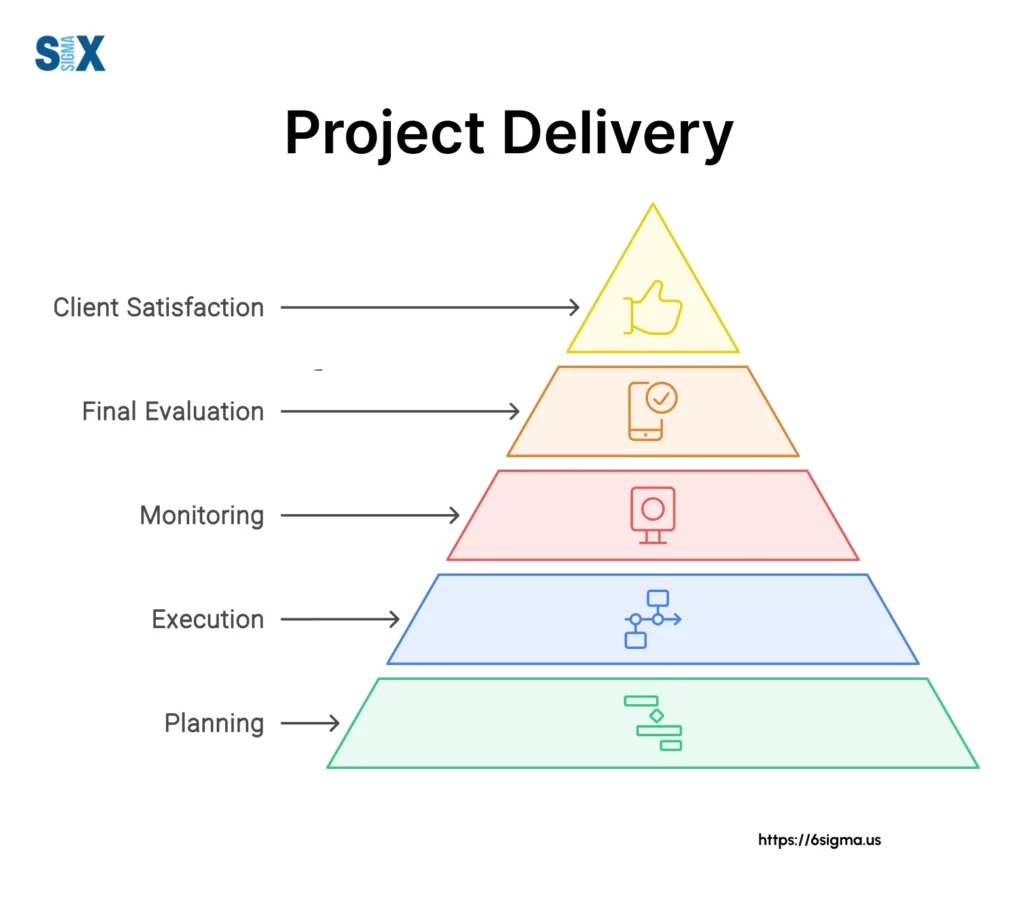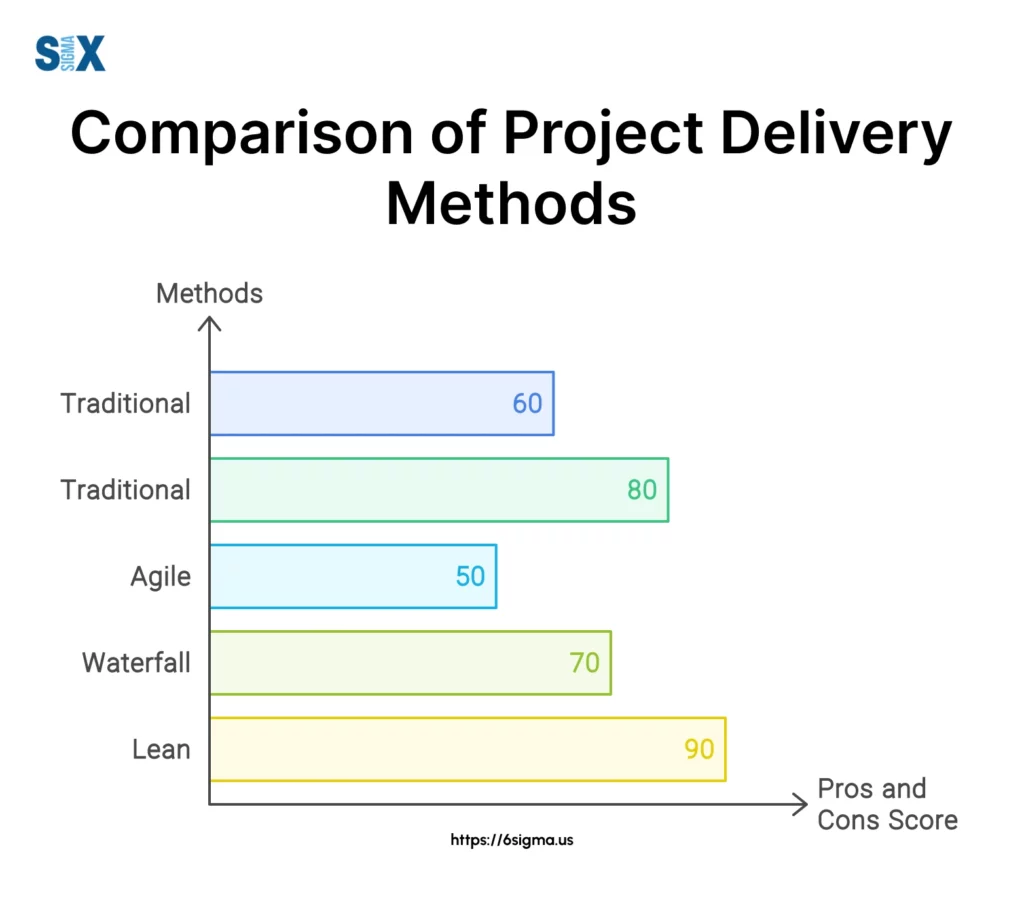How to Choose the Right Project Delivery Method for Your Project
Project delivery, at its core, is the systematic approach to planning, executing, and completing projects to achieve specific objectives within defined constraints.
It encompasses a wide range of methodologies, tools, and techniques designed to ensure that projects are completed on time, within budget, and to the required quality standards.
Key Highlights
- Defining project delivery and its lifecycle components
- Comparing traditional and innovative delivery methods
- Strategies for effective planning and risk mitigation
- Techniques for optimizing project execution and monitoring
- Integrating Agile and Waterfall approaches in delivery
- Leveraging technology for enhanced project performance
- Best practices for project closure and evaluation
Understanding Project Delivery
It’s not just about getting things done; it’s about orchestrating a symphony of tasks, people, and resources to create something amazing.

Defining Project Delivery and Its Importance
Project delivery is the process of taking an idea from conception to reality.
It’s like baking a cake, but instead of flour and eggs, you’re mixing planning, execution, and a whole lot of teamwork.
Why is it important?
Well, without a solid project delivery approach, you might end up with a half-baked result that satisfies no one.
Key Components of the Project Lifecycle
The project lifecycle is like a journey, and every journey has its stages.
We start with initiation (the spark of an idea), move on to planning (mapping out our route), then execution (the actual road trip), monitoring and controlling (making sure we don’t get lost), and finally, closing (reaching our destination and celebrating).
Stakeholder Management in Project Delivery
Ah, stakeholders – the backseat drivers of the project world. Managing them is crucial because they can make or break your project.
It’s about keeping everyone in the loop, managing expectations, and sometimes, playing peacemaker when opinions clash.
Introduction to project delivery concepts with Lean Six Sigma White Belt

Project Delivery Methods
Now, let’s talk about the different ways you can get from A to B in the project world.
Design-bid-build: The Traditional Approach
This is the granddaddy of project delivery methods.
It’s like a relay race: the designer hands off to the bidder, who then passes the baton to the builder. It’s straightforward but can be time-consuming.
Design-build: Streamlining the Process
Think of this as a one-stop-shop. The designer and builder are on the same team from the get-go.
It’s faster and can lead to fewer conflicts, but it might give you less control over the design.
Integrated Project Delivery: A Collaborative Model
This is the kumbaya of project delivery methods. Everyone – owner, designer, contractor – joins hands and works together from start to finish.
It’s great for complex projects but requires a lot of trust and communication.
Construction Management At Risk
In this method, you bring in a construction manager early to oversee the project and guarantee a maximum price.
It’s like having a financial advisor for your project – they help manage risks and costs.
Choosing the Right Delivery Method for Your Project
Picking the right method is like choosing the right tool for a job.
Consider your project’s complexity, timeline, budget, and how much control you want. There’s no one-size-fits-all solution, so choose wisely!
Learn the different approaches to project delivery with Lean Six Sigma Green Belt

Planning and Initiating Project Delivery
We should proceed further with the chosen method for seamless process!
Defining Project Scope and Objectives
This is where we draw the map for our journey.
What are we trying to achieve? What’s included and what’s not? Being clear about this from the start can save a lot of headaches later.
Budget Planning and Cost Control Strategies
Money makes the world go round, and it certainly makes projects happen.
Planning your budget is like planning a diet – you need to know what you’re consuming and where you might need to cut back.
Risk Assessment and Mitigation Techniques
Every project has its risks. Identifying and planning for them is like packing an umbrella – you hope you won’t need it, but you’ll be glad you have it if it rains.
Resource Allocation and Procurement Processes
This is about making sure you have the right people, tools, and materials at the right time.
It’s like cooking a complex meal – you need to make sure all your ingredients are prepped and ready when you need them.
Executing and Monitoring Project Delivery
Executing the project is the one of the most important part of the process. There are few steps you need to understand before executing the plan.
Timeline Management and Schedule Optimization
Time is money, folks.
Keeping your project on schedule is like conducting an orchestra – everything needs to happen at the right moment for the performance to be a success.
Quality Assurance and Performance Metrics
Quality isn’t just about the end product; it’s about the entire process.
Setting up metrics and checkpoints is like having a GPS for your project – it helps you stay on track and alerts you when you’re veering off course.
Change Management in Project Delivery
Change is inevitable, but it doesn’t have to derail your project.
Good change management is like being a skilled sailor – you can adjust your sails to changing winds without losing sight of your destination.
Effective Communication Strategies
Communication is the oil that keeps the project machine running smoothly.
Regular updates, clear channels, and open dialogue can prevent a lot of problems before they start.
Contract Administration and Project Oversight
This is about keeping all the paperwork in order and making sure everyone’s playing by the rules.
It’s not the most exciting part, but it’s crucial for keeping your project legally sound and running smoothly.
Best project execution and monitoring techniques to know with Lean Six Sigma Black Belt
Agile and Waterfall Approaches in Project Delivery
Understand the two popular philosophies in the project world.
Understanding Agile methodologies in Project Management
Agile is all about flexibility and iteration.
It’s like jazz – there’s a structure, but there’s also room for improvisation and adaptation as you go along.
The Waterfall Approach: Benefits and Limitations
Waterfall is the classical music of project management – everything happens in a predetermined sequence.
It’s great for projects with clear, unchanging requirements, but can be rigid in the face of change.
Hybrid models: Combining Agile and Waterfall
Why choose when you can have both?
Hybrid models take the best of both worlds, giving you structure where you need it and flexibility where it counts.
Lean Construction and Value Engineering Techniques
These approaches are all about efficiency and eliminating waste. It’s like being a minimalist – you focus on what truly adds value and cut out the rest.
Technological Advancements in Project Delivery
Welcome to the digital age of project delivery!
Project Management Software and Tools
From Gantt charts to collaboration platforms, there’s a tool for every aspect of project management.
These tools are versatile and indispensable.
Building Information Modeling (BIM) in Project Delivery
BIM is revolutionizing construction projects. It’s like having a digital twin of your project, allowing you to spot issues and optimize designs before laying a single brick.
Collaborative Planning Platforms
These platforms bring everyone together in a virtual space. It’s like having a war room for your project where everyone can contribute and stay updated in real-time.
Data Analytics for Project Performance Optimization
Big data isn’t just for tech companies. By analyzing project data, you can spot trends, predict issues, and make informed decisions. It’s like having a crystal ball for your project.
Project Closeout and Evaluation
This is where we tie up all the loose ends. Good documentation is like leaving a well-organized desk for the next person – it makes life easier for everyone involved.
Evaluating Project Success
Time for some honest reflection.
What went well? What could we improve?
This isn’t about pointing fingers; it’s about growing and getting better for the next project.
Post-project Analysis
The project might be over, but the learning continues. Use the insights from your evaluation to refine your processes and approach for future projects.
Building Long-term Relationships with Stakeholders
A successful project isn’t just about the end result; it’s about the relationships you build along the way. Nurture these connections – they’re the foundation for future success.
Remember, every project is unique, but with these principles in your toolkit, you’re well-equipped to tackle whatever comes your way.
SixSigma.us offers both Live Virtual classes as well as Online Self-Paced training. Most option includes access to the same great Master Black Belt instructors that teach our World Class in-person sessions. Sign-up today!
Virtual Classroom Training Programs Self-Paced Online Training Programs






